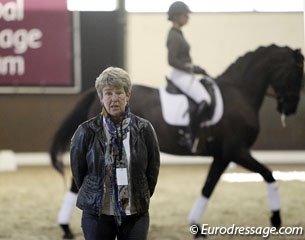
The first day of the 2011 Global Dressage Forum finished on a high when Nathalie zu Sayn-Wittgenstein completed her demonstration of harmonious and unpressured training of dressage horses. The beginning of the second day of the Forum would be no different with Nathalie’s trainer Kyra Kyrklund speaking on collection.
While stepping onto the podium Kyra said “I like doing this much more than the politics that went on yesterday, but sometimes that has to happen too.”
For her session on collection Kyra brought along two of her students, the British Sarah Millis on the 6-year old Finnish warmblood Constantinus (by Fairplay x Matador) and Swedish GP team rider Cecilia Dorselius on the Westfalian Lennox (by Laurentianer x Florestan).
Collection of Body and Step
Kyra started out with discussing the concept of collection. “It is collection of the body and of the step,” she stated. “The old masters said you collect the horse between the hand and the leg, bit and spur. I think it’s a good picture to keep in mind. When the horse gets long in the frame, the rider feels that he’s not forward enough and then they make the legs go more forward, but the body is not collected. I try to work on collecting the body first, than the legs.”
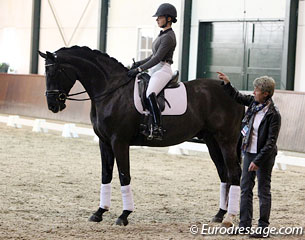 The seat is also essential for achieving balanced horses. “The rider has to have an independent seat. Weight is not really an aid, but you can use it whenever you need it with the hand and the leg.”
The seat is also essential for achieving balanced horses. “The rider has to have an independent seat. Weight is not really an aid, but you can use it whenever you need it with the hand and the leg.”
Besides relying on the visualisation of collection by the old masters, she also implements science to her training techniques. “Andrew Mclean says horses work with pressure and release. You have to reward the horse by releasing. My main goal is to reach Grand Prix with each horse, but not all of them get there. You can easily ride a Prix St Georges without proper collection.”
Collection of the body and legs became the key phrase throughout the demo. “You use your lower leg without letting the horse run away,” Kyra explained. “A lot of riders think they can lift the horse up with the lower leg but that’s Munchhausen. With a short and collected body you can let loose of the reins.”
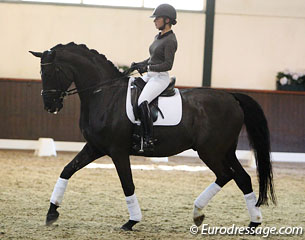 On the sturdy but super talented Constantinus Millis showed how the horse slowly took more weight on the hindquarters while staying light in the hand and uphill in the frame.
On the sturdy but super talented Constantinus Millis showed how the horse slowly took more weight on the hindquarters while staying light in the hand and uphill in the frame.
“With the younger horse I work on collection more in the gait that is easier for him. He will get better in the weaker gait as he gradually gets stronger.”
Kyra uses tempo changes as the main exercise to train collection. “I like trot-canter transitions, but watch out the horse doesn’t get croup high in the transition. It’s an excellent exercise for the balance of the horse and for the co-ordination of the rider’s aids.” Kyra stressed that one needs to feel the outer hind leg on the ground to decide the moment for a canter strike off.
“When trainers say ride more forward? What do they mean? Short quick steps, longer strides? The horse will choose the option that is easier for him,” she added.
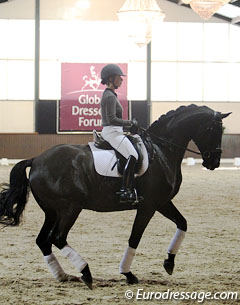 Constantinus showed a first few piaffe half steps but he got crooked in the body. “It’s more important to have the horse straight than have the piaffe steps,” Kyra emphasized.
Constantinus showed a first few piaffe half steps but he got crooked in the body. “It’s more important to have the horse straight than have the piaffe steps,” Kyra emphasized.
When Millis rode a left working pirouette, Kyra explained that the rider needs to “work on the horse carrying the left side of his neck and breast (to keep it up). Don’t forget to work on straightness as well as he was falling into the inside of the pirouette.”
Constantinus has only been with Kyra for four months and Sarah rode him a maximum of 10 times just to present him at the Forum so Kyra could do the talking. The dark bay has not been out much and shied from the clapping of the audience at the end of his ride. Kyrklund applied the McLean method of approach conditioning asking the audience to do a baby clap and as soon as the horse took a step forwards towards the audience stop clapping. Like this the horse gets the impression that he makes the clapping stop by stepping forward and controls the frightening sound and situation.
Enter Cecilia Dorselius on Lennox
These shooting stars from Sweden made their major break through in 2011 landing a spot on the Swedish team in their first year at international level.
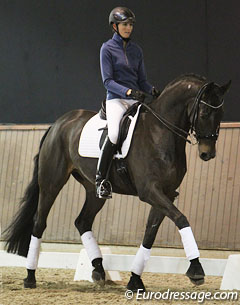 “I saw them for the first time last year and Cecilia had to warm him up a long time and had difficulties getting him in the show ready frame,” Kyra reminisced. “The first time I saw Lennox I thought he was boring, but then he popped together.”
“I saw them for the first time last year and Cecilia had to warm him up a long time and had difficulties getting him in the show ready frame,” Kyra reminisced. “The first time I saw Lennox I thought he was boring, but then he popped together.”
The graceful Cecilia is a pleasure to watch but her beauty in the saddle needed nurturing. “We worked a lot on her seat,” Kyra admitted. “The rider has to be able to position himself above the center of gravity. You have the seat bone and the pubic bone. On that triangle you sit. Those bones are hard and bumpy, but the bum is a cushion to sit on. If the rider is tense in the legs, the cushion gets hard and then you bump in the saddle. Don’t squeeze with the leg to push the horse forward. He will get too heavy for you and you get too tense in the legs and hang on too much with the hand.”
Lennox coughed a few times and Kyra asked for a door to be opened so more fresh air could flow into the arena. “Canter a bit more forward so he can breathe a couple of times,” Kyra told Cecilia. “Often when you transport the horse you can get slime in the throat. So let the neck out so they can stretch. It’s not a fever because we always take the temperature three times a day after travelling.”
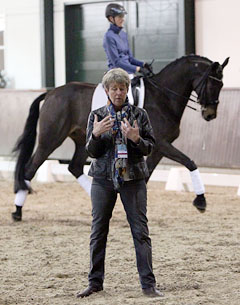 While the Swedish rider was doing a working canter, Kyra paid close attention. “Lengthen the steps, but if he hangs forward, still collect the body first before getting bigger steps.” Kyra gave another tip for the canter work. “Carry the whip in the outside hand when you do the canter because if you use it on the inside, the inside hind leg will go down too quickly.”
While the Swedish rider was doing a working canter, Kyra paid close attention. “Lengthen the steps, but if he hangs forward, still collect the body first before getting bigger steps.” Kyra gave another tip for the canter work. “Carry the whip in the outside hand when you do the canter because if you use it on the inside, the inside hind leg will go down too quickly.”
Kyra is well known for her ability to collect horses to the utmost while they stay balanced and stressfree. The pirouettes of her horses are usually with good jump and much lift in the forehand but at a slow pace. Lennox did it no diferently.
“David Hunt will be saying that it’s too slow,” Kyra remarked. “But I want the horse to be confident in the collection. Make them go that slow without panicking and using too much inside leg in that moment. At home I don’t train many small pirouettes, I want them to think forward. ”
Kyra did not hesitate to tell the rider to reward the horse with the outside hand, loosening the outside rein while doing so.
The session finished with a bit of piaffe-passage training. Lennox has a gorgeous silhouette in passage and Kyra stressed that the rider has to stay calm in the saddle. “Let your waist stay still and let him jump under you. Think that the passage starts from the hind legs. He has to be straight without the rider lifting him up. Equal steps all the time.”
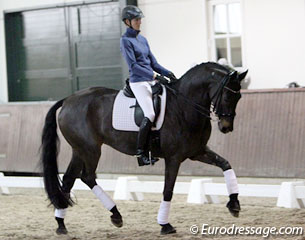 Lennox piaffe was quite small a year ago with not enough lift in the front leg, but Kyra and Cecilia worked on that by slowing down the tempo of the passage gradually into piaffe. “You have different passages: shorter and quicker, and a longer one with more front leg, but you have to adjust it for him to do the transitions to and from piaffe. Passage, shorter passage, then piaffe and forward.”
Lennox piaffe was quite small a year ago with not enough lift in the front leg, but Kyra and Cecilia worked on that by slowing down the tempo of the passage gradually into piaffe. “You have different passages: shorter and quicker, and a longer one with more front leg, but you have to adjust it for him to do the transitions to and from piaffe. Passage, shorter passage, then piaffe and forward.”
During the panel discussion Kyra made an interesting statement on halft halts. “I put half halts in the dustbin,” she said frankly. “It’s saying rebalance the horse. But why? Is he running fast, is he heavy in front or not collecting in the tummy. It’s really saying, “ride better.””
Kyra agrees with Dr. Hilary Clayton that all canter becomes 4-beat in a pirouette, but David Hunt disagreed and stated, “I don’t like the canter away from the 3-beat in the pirouette. The hind legs are too close together, lose all the energy. You lose the correctness of the beat. For me it’s a series of rears. For me collection is the horse comes together as much as he can, still maintaining the quality and the raising the energy.”
 Australian Olympian Hayley Beresforfd remarked that to her it’s thought-provoking to hear Kyra say that the outside rein can be loosened to pat the horse as well for testing the balance and contact. Beresford said she has been religiously taught ‘inside leg to outside rein’.
Australian Olympian Hayley Beresforfd remarked that to her it’s thought-provoking to hear Kyra say that the outside rein can be loosened to pat the horse as well for testing the balance and contact. Beresford said she has been religiously taught ‘inside leg to outside rein’.
Kyra replied the following: “One of the dangerous things is riding when someone says, ‘this is the right way’. Then you can’t get it out of your head. For 35-years I have done that but then you come to a point where it’s not working. With the pirouettes I use the outside rein more, like a cowboy. In the pirouettes the horse has to be relaxed in the neck to the inside. I don’t want the horse to feel trapped in the pirouette. He has to jump up every step and I have to balance him with the outside rein.”
Kyra is open to try new training techniques but always respectful of the horse and achieving balance and harmony as main goal without putting undue pressure on it. “I’m not convinced that dressage is one aid at the time, but I’m very adventurous and tell my students just try it once. I think horses are trying to train us. If you always do what you always did, you always get what you always got.”
Next Page of the report: Wust and Ernes on Training Judges
Text & Photos © Astrid Appels/Eurodressage.com - No Reproduction Allowed without permission
Eurodressage Coverage of the 2011 Global Dressage Forum